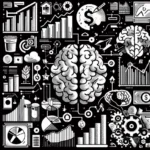Table of Contents
Trading With AI
In the world of finance, trading has always been a high-stakes game of risk and reward. For years, traders have relied on a mix of experience, intuition, and luck to make the right trades at the right time. But with the rise of Artificial Intelligence and Machine Learning, the game is changing. These technologies are transforming the trading industry, allowing traders to analyze vast amounts of data, identify patterns, and make better, more informed decisions. In this article, we’ll take a closer look at how Artificial Intelligence and Machine Learning are being used in trading, and explore some of the benefits and challenges of these technologies.
The Benefits of Artificial Intelligence and Machine Learning in Trading
Artificial Intelligence and Machine Learning offer several key benefits to traders, including:
1. Improved Analysis
One of the biggest advantages of Artificial Intelligence and Machine Learning is their ability to analyze vast amounts of data quickly and accurately. These technologies can sift through mountains of financial data, identify patterns, and make predictions about market trends. This allows traders to make more informed decisions and reduces the risk of making costly mistakes.
2. Increased Efficiency
Artificial Intelligence and Machine Learning can also help traders work more efficiently. These technologies can automate many routine tasks, such as data entry and analysis, freeing up time for traders to focus on more strategic activities. This can help traders make better use of their time, and ultimately improve their performance.
3. Better Risk Management
Another advantage of Artificial Intelligence and Machine Learning is their ability to help traders manage risk. These technologies can analyze historical data to identify potential risks and provide recommendations for mitigating them. This can help traders avoid costly mistakes and reduce the risk of losses.
The Challenges of Artificial Intelligence and Machine Learning in Trading
While Artificial Intelligence and Machine Learning offer many benefits to traders, they also present several challenges. Some of the main challenges include:
1. Complexity
Artificial Intelligence and Machine Learning can be complex and difficult to understand, especially for traders who are not familiar with these technologies. This can make it challenging for traders to effectively leverage these technologies in their trading strategies.
2. Cost
Implementing Artificial Intelligence and Machine Learning in trading can also be expensive. Traders may need to invest in specialized hardware, software, and data analysis tools to effectively use these technologies. This can be a barrier to entry for some traders, particularly those who are just starting out.
3. Reliance on Data
Artificial Intelligence and Machine Learning rely heavily on data to make accurate predictions and recommendations. If the data is flawed or incomplete, the results generated by these technologies may be inaccurate or misleading. Traders need to ensure that they have access to high-quality, reliable data to effectively leverage these technologies.
How Traders Can Leverage Artificial Intelligence and Machine Learning
Despite the challenges, there are several ways that traders can leverage Artificial Intelligence and Machine Learning to improve their trading strategies. Some of the key strategies include:
1. Use Predictive Analytics
Predictive analytics is a key application of Artificial Intelligence and Machine Learning in trading. Traders can use predictive analytics to identify patterns in financial data and make predictions about future market trends. This can help traders make more informed decisions and reduce the risk of losses.
2. Implement Algorithmic Trading
Algorithmic trading involves using computer algorithms to make trading decisions. These algorithms can be based on a range of factors, including market trends, news events, and other data. By leveraging Artificial Intelligence and Machine Learning, algorithmic trading can be optimized to make more accurate predictions and improve trading performance.
3. Use Sentiment Analysis
Sentiment analysis is a technique used to analyze social media and other online content to gauge public sentiment towards a particular stock or market. By leveraging Artificial Intelligence and Machine Learning, traders can use sentiment analysis to get a better understanding of how the market is likely to respond to news events and other factors.
4. Automate Routine Tasks
As mentioned earlier, Artificial Intelligence and Machine Learning can be used to automate routine tasks, freeing up time for traders to focus on more strategic activities. This can include data entry, analysis, and even trade execution. By automating these tasks, traders can work more efficiently and make better use of their time.
5. Continuously Learn and Adapt
Finally, it’s important for traders to continuously learn and adapt their strategies based on the insights generated by Artificial Intelligence and Machine Learning. By analyzing performance data and adjusting their strategies accordingly, traders can continually improve their performance and stay ahead of the competition.
List of AI Trading Tools and Machine Learning Trading Software
1. Algorithmic Trading
Algorithmic Trading involves the use of computer programs to execute trades based on predefined rules and conditions. The algorithms can analyze vast amounts of data, identify patterns, and make decisions faster and more accurately than human traders.
2. Sentiment Analysis
Sentiment Analysis uses natural language processing and machine learning techniques to analyze social media, news, and other sources of information to gauge the market sentiment. This information can help traders make better-informed decisions and predict market trends.
3. Predictive Analytics
Predictive Analytics uses machine learning algorithms to analyze historical data and predict future market trends. This can help traders identify patterns and make informed decisions about when to buy or sell assets.
4. Robo-advisors
Robo-advisors are digital platforms that use AI and ML algorithms to provide personalized investment advice and portfolio management. They can analyze an investor’s risk tolerance, investment goals, and market trends to recommend investment options that align with their objectives.
5. Pattern Recognition
Pattern Recognition uses machine learning algorithms to identify patterns in the market that human traders may not be able to see. This can help traders make more accurate predictions and make informed decisions about when to buy or sell assets.
Conclusion
Artificial Intelligence and Machine Learning are transforming the trading industry, offering traders new ways to analyze data, identify patterns, and make more informed decisions. While there are certainly challenges to implementing these technologies, the benefits are clear. By leveraging Artificial Intelligence and Machine Learning, traders can work more efficiently, manage risk more effectively, and ultimately improve their performance. As the trading industry continues to evolve, it’s likely that we’ll see even more advanced applications of these technologies in the years to come.









![Funded Picker Review (2025) + 15% Discount Code [PFR15] 9 funded picker](https://propfirmreviews.net/wp-content/uploads/2025/08/funded-picker-1024x576.jpg)



